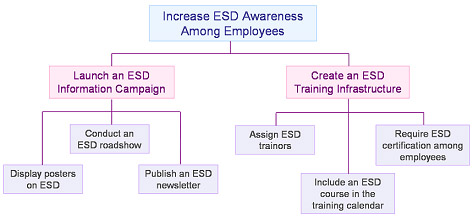|
The Tree
Diagram
The
Tree Diagram
is an analysis tool for breaking down a broad or top-level goal of a
team into many levels of increasingly detailed and specific actions that
need to be done in order to achieve the stated goal. As its name
implies, the tree diagram consists of branches that specify the actions
required at each level of detail. These branches further branch out into
smaller branches that break down these actions into more detailed or
specific actions. The branching out continues until the desired
level of detail is reached.
The tree
diagram is good for: 1) defining specific
'real-world'
actions to
support any given goal; 2) ensuring that all actions being pursued by a
team are
tied
to the
primary goal of the team; 3) training team members to come up with the
appropriate steps to achieve a higher goal; 4) facilitating the
monitoring of the progress of various activities since these are
organized at different levels that have their own sub-goals; 5)
revealing the 'true' complexity level of a goal by systematically
presenting the actions and resources needed to attain that goal; 6)
making the distribution of assignments or responsibilities to team
members easier.
To
construct
a tree diagram, the following steps may be followed:
1) assemble the right
team once the goal has been chosen by management;
2) state the goal of
the team and write this goal statement in a box at the crown (topmost
part) of the tree diagram;
- as an example, the goal statement in Figure 1
is aimed at increasing the awareness of personnel about electrostatic
discharge (ESD) and its effects;
|
Increase ESD Awareness Among Employees |
Figure
1. Example of a Goal Statement for a Tree Diagram
3) generate the tree
diagram's
major headings,
which are the major sub-goals supporting the primary goal; write these
headings in boxes held by branches coming out of the primary goal;
- the
major headings of a tree diagram are usually generated through
brainstorming;
- going
back to the previous example, major sub-goals supporting the
primary goal stated in Figure 1 may include the following: a) launch an ESD information campaign; and b) create an ESD training infrastructure;
4) break each major
heading into several sub-goals (or actions) of greater detail; again,
these sub-goals (or actions) are usually generated through
brainstorming;
write these sub-goals or actions in boxes held by branches coming out of
the respective major heading;
- in
simple cases, the third level of headings (or the headings supporting
the major sub-goals) may already contain specific actions;
5) continue breaking
down each level into greater detail through brainstorming until the level of specific actions
are reached for each sub-goal;
6)
polish
the tree diagram by subjecting it to team review(s) then finalize it;
- see Figure
2 for a simple but complete tree diagram corresponding to the goal
statement in Figure 1.

Figure
2. Example of a simple Tree Diagram for the goal in Figure 1
See Also:
Matrix Diagram;
Affinity Diagram
HOME
Copyright
©
2004-2005
EESemi.com.
All Rights Reserved.
|

